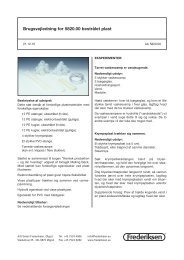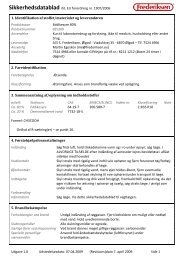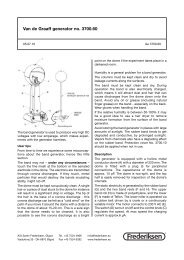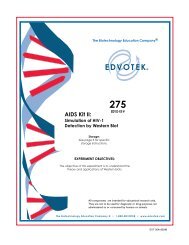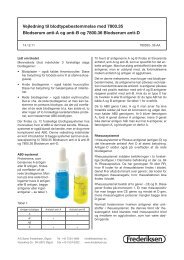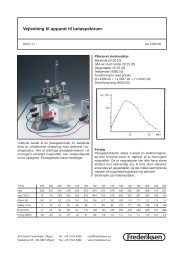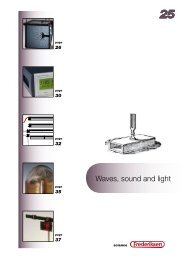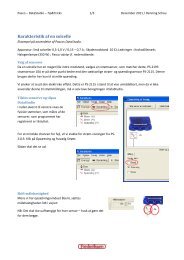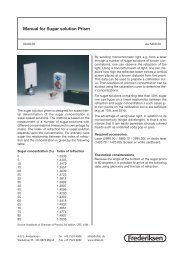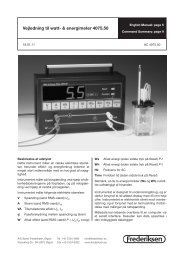255 - Frederiksen
255 - Frederiksen
255 - Frederiksen
- No tags were found...
Create successful ePaper yourself
Turn your PDF publications into a flip-book with our unique Google optimized e-Paper software.
26EDVO-Kit #<strong>255</strong>Material Safety Data SheetsFull size (8.5 x 11”) pdf copy of MSDS available at www.edvotek.com or by request.EDVOTEK®Material Safety Data SheetMay be used to comply with OSHA's Hazard CommunicationStandard. 29 CFR 1910.1200 Standard must be consulted forspecific requirements.IDENTITY (As Used on Label and List) Note: Blank spaces are not permitted. If any item is notapplicable, or no information is available, the space must10x Tris Glycine Bufferbe marked to indicate that.Section IManufacturer's NameEmergency Telephone NumberEDVOTEK, Inc.Address (Number, Street, City, State, Zip Code)14676 Rothgeb DriveRockville, MD 20850Telephone Number for information(301) 251-5990Date Prepared05/07/07Signature of Preparer (optional)(301) 251-5990Section II - Hazardous Ingredients/Identify InformationHazardous Components [SpecificChemical Identity; Common Name(s)] OSHA PEL ACGIH TLVOther LimitsRecommended % (Optional)Glycine (C2H5NO2) ---------------------No data-----------------CAS # 56-40-6TrisCAS # 77-86-1Section III - Physical/Chemical CharacteristicsBoiling PointNo dataSpecific Gravity (H 0 = 1)2No dataVapor Pressure (mm Hg.)Vapor Density (AIR = 1)No dataNo dataMelting PointEvaporation Rate(Butyl Acetate = 1)No dataNo dataSolubility in WaterSolubleAppearance and OdorClear, no odorSection IV - Physical/Chemical CharacteristicsFlash Point (Method Used)Flammable Limits LELUELExtinguishing MediaNo data No data No dataWater spray, carbon dioxide, dry chemical powder or appropriate foamSpecial Fire Fighting ProceduresWear SCBA and protective clothingUnusual Fire and Explosion HazardsMay emit toxic fumesSection V - Reactivity DataStabilityUnstableConditions to AvoidStable XIncompatibilityStrong oxidizing agentsHazardous Decomposition or ByproductsCarbon monoxide, carbon dioxide, nitrogen oxidesHazardousPolymerizationWill Not OccurSection VI - Health Hazard DataRoute(s) of Entry: Inhalation? Skin?Ingestion?Health Hazards (Acute and Chronic)May Occur Conditions to AvoidCarcinogenicity: NTP? IARC Monographs? OSHA Regulation?No data No data No data No dataSigns and Symptoms of ExposureIrritationXYes Yes YesMay cause irritation to eyes, skin, and mucous membranes.Medical Conditions Generally Aggravated by ExposureUnknownEmergency First Aid ProceduresSection VII - Precautions for Safe Handling and UseSteps to be Taken in case Material is Released for SpilledWaste Disposal MethodPrecautions to be Taken in Handling and StoringSkin/eye contact: flush w/ water. Inhalation: remove to fresh air.Ingestion: Seek medical attentionWear respirator and protective clothing. Mop up with absorbant material and disposeof properly.Burn in chemical incinerator equipped w/ afterburner and scrubber.Follow all state, federal, and local regulations.Avoid contact, keep away from heat.Other PrecautionsNoneSection VIII - Control MeasuresRespiratory Protection (Specify Type)Ventilation Local Exhaust SpecialProtective GlovesMechanical (General)NoYesOtherNoneNoneRubber or PE Eye Protection Safety gogglesOther Protective Clothing or EquipmentLab coat, coverallsWork/Hygienic PracticesPrevent contactEDVOTEK®Material Safety Data SheetMay be used to comply with OSHA's Hazard CommunicationStandard. 29 CFR 1910.1200 Standard must be consulted forspecific requirements.IDENTITY (As Used on Label and List) Note: Blank spaces are not permitted. If any item is notapplicable, or no information is available, the space mustSephadexbe marked to indicate that.Section IManufacturer's NameEmergency Telephone NumberEDVOTEK, Inc.Address (Number, Street, City, State, Zip Code)14676 Rothgeb DriveRockville, MD 20850Telephone Number for information(301) 251-5990Date Prepared05/07/07Signature of Preparer (optional)(301) 251-5990Section II - Hazardous Ingredients/Identify InformationHazardous Components [SpecificChemical Identity; Common Name(s)] OSHA PEL ACGIH TLVData not availableCAS# 9050-94-6Other LimitsRecommended % (Optional)Section III - Physical/Chemical CharacteristicsBoiling PointNo dataSpecific Gravity (H 0 = 1)2No dataVapor Pressure (mm Hg.)Vapor Density (AIR = 1)No dataNo dataMelting PointEvaporation Rate(Butyl Acetate = 1)No dataNo dataSolubility in WaterNo dataAppearance and OdorWhite powderSection IV - Physical/Chemical CharacteristicsFlash Point (Method Used)Flammable Limits LELUELExtinguishing MediaNo data No data No dataWater spray, Carbon dioxide, dry chemical powder, foamSpecial Fire Fighting ProceduresWear SCBA and protective clothing to prevent contact with skin and eyes.Unusual Fire and Explosion HazardsEmits toxic fumes under fire conditionsSection V - Reactivity DataStabilityUnstableConditions to AvoidStable XNoneIncompatibilityNo data availableHazardous Decomposition or ByproductsHazardousPolymerizationWill Not OccurSection VI - Health Hazard DataMay Occur Conditions to AvoidRoute(s) of Entry: Inhalation? Skin?Ingestion?Health Hazards (Acute and Chronic)XYes Yes YesIrritatingCarcinogenicity: NTP? IARC Monographs? OSHA Regulation?Signs and Symptoms of ExposureNo data availableMedical Conditions Generally Aggravated by ExposureEmergency First Aid ProceduresSection VII - Precautions for Safe Handling and UseSteps to be Taken in case Material is Released for SpilledYes Yes YesNo dataSkin/eye contact: Flush eyes with copious amounts of waterInhalation: Remove to fresh air Ingestion: Wash out mouth with waterSweep up, place in a bag and hold for waste disposalWaste Disposal MethodNormal solid waste disposalPrecautions to be Taken in Handling and StoringNoneOther PrecautionsNoneSection VIII - Control MeasuresRespiratory Protection (Specify Type)Chemical cartridge respirator with full face maskVentilation Local Exhaust YesSpecialMechanical (General) Yes OtherYesProtective GlovesYes Eye ProtectionYesOther Protective Clothing or EquipmentNoneWork/Hygienic PracticesDo not ingest. Avoid contact with skin/eyes.EDVOTEK®Material Safety Data SheetMay be used to comply with OSHA's Hazard CommunicationStandard. 29 CFR 1910.1200 Standard must be consulted forspecific requirements.IDENTITY (As Used on Label and List) Note: Blank spaces are not permitted. If any item is notapplicable, or no information is available, the space mustProtein Plus Stainbe marked to indicate that.Section IManufacturer's NameEmergency Telephone Number(301) 251-5990EDVOTEK, Inc.Telephone Number for informationAddress (Number, Street, City, State, Zip Code)(301) 251-599014676 Rothgeb DriveRockville, MD 20850Date Prepared05/07/07Signature of Preparer (optional)Section II - Hazardous Ingredients/Identify InformationHazardous Components [SpecificChemical Identity; Common Name(s)] OSHA PEL ACGIH TLVOther LimitsRecommended % (Optional)Methanol (Methyl Alcohol) 200ppm 200ppm No data 90%-100%CH3OHSection III - Physical/Chemical CharacteristicsBoiling Point65°CSpecific Gravity (H 0 = 1)2.79Vapor Pressure (mm Hg.)Melting Point96mmHgEvaporation RateVapor Density (AIR = 1)1.11 (Butyl Acetate = 1)N/A4.6Solubility in WaterComplete (100%)Appearance and OdorBlue liquid/alcoholic, pungent odorSection IV - Physical/Chemical CharacteristicsFlash Point (Method Used)Extinguishing MediaFlammable Limits LELUEL(closed cup) 12°C 6.0% 36%Use alcohol foam, dry chemical or carbon dioxide. (Water may be ineffective)Special Fire Fighting ProceduresWear SCBA with full facepiece operated in positive pressure mode.Move containers from fireareaUnusual Fire and Explosion Hazards Vapors may flow along surfaces to distant ignition sources.Close containers exposed to heat may explode. Contact w/ strong oxidizers may cause fire.Section V - Reactivity DataStabilityUnstableConditions to AvoidStable X NoneIncompatibilityStrong oxidizing agentsHazardous Decomposition or ByproductsCarbon monoxide, Carbon dioxide, Sulfur oxidesHazardousMay Occur Conditions to AvoidPolymerizationWill Not Occur X NoneSection VI - Health Hazard DataRoute(s) of Entry: Inhalation? Skin?Ingestion?Yes Yes YesHealth Hazards (Acute and Chronic) Irritating to eyes, skin, mucous membranes and upper respiratory tract.Chronic exposure may cause lung damage or pulmonary sensitizationCarcinogenicity: NTP? IARC Monographs?OSHA Regulation?No data No data No dataSigns and Symptoms of ExposureRespiratory tract: burning sensation. Coughing, wheezing, laryngitis, shortness of breath, headacheMedical Conditions Generally Aggravated by ExposureNo dataEmergency First Aid ProceduresFlush skin/eyes w/ large amounts of water. If inhaled, remove to fresh air. Ingestion: give large amountsof water or milk. Do not induce vomiting.Section VII - Precautions for Safe Handling and UseSteps to be Taken in case Material is Released for SpilledEvacuate area. Wear SCBA, rubber boots and rubber gloves. Mop up w/ absorptive material and burn inchemical incinerato equipped w/ an afterburner and scrubber.Waste Disposal MethodObserve all federal, state, and local laws.Precautions to be Taken in Handling and StoringWear protective gear. Avoid contact/inhalation.Other PrecautionsStrong sensitizerSection VIII - Control MeasuresRespiratory Protection (Specify Type)NIOSH/MSHA approved respiratorVentilation Local Exhaust No Special Chem fume hoodMechanical (General) No OtherNoneProtective GlovesRubberEye ProtectionSplash-proof gogglesOther Protective Clothing or EquipmentRubber bootsWork/Hygienic PracticesAvoid prolonged or repeated exposure



